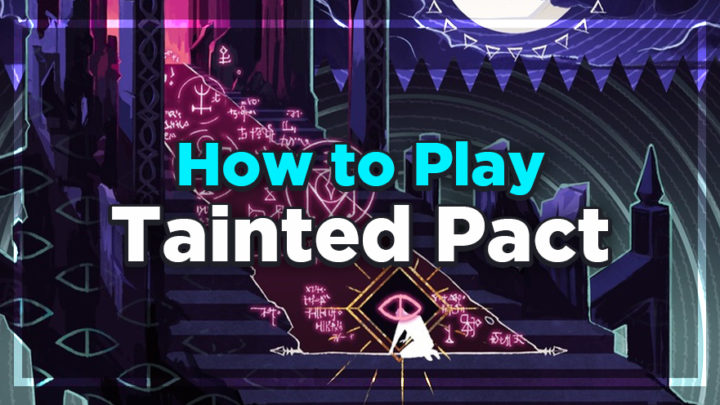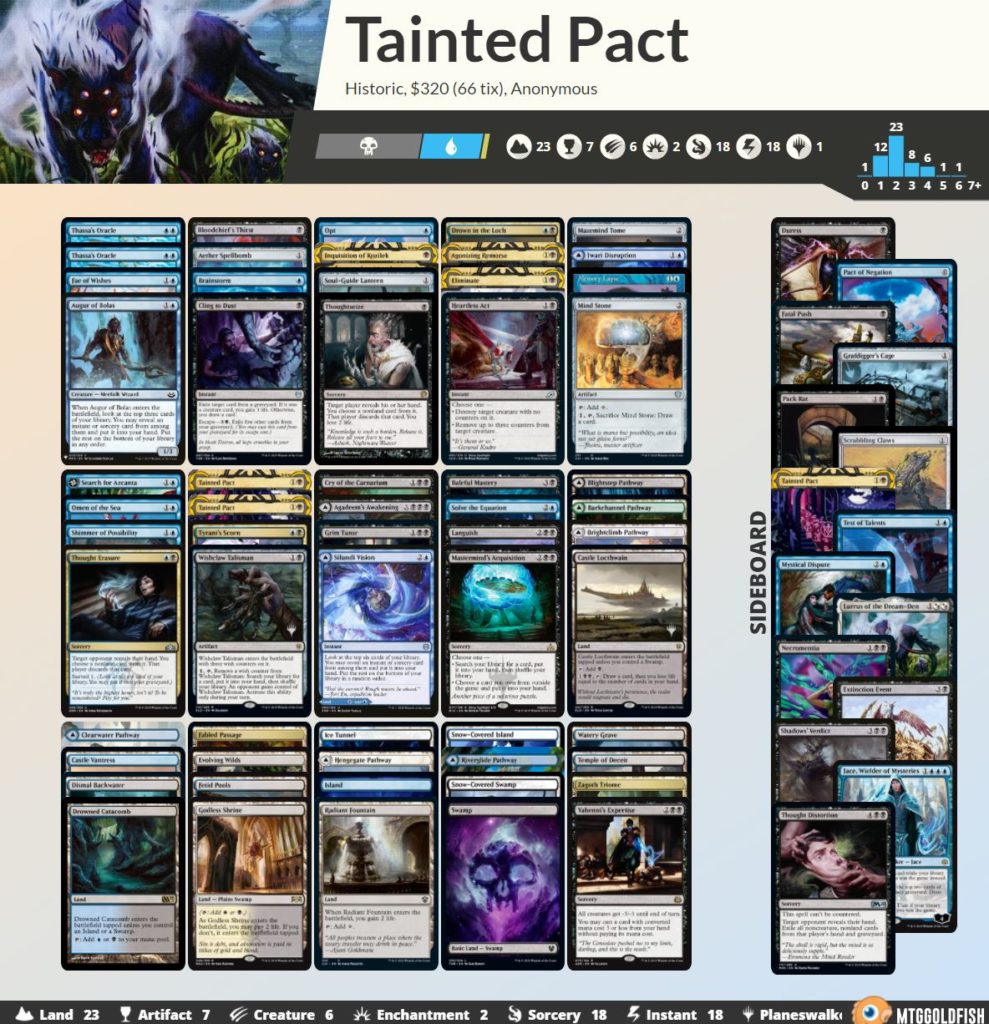Historic has been at the forefront of everyone’s minds since the injection of Mystical Archive into the format, and few cards have been as hyped up as Tainted Pact. Last weekend’s Star City Games $5K Strixhaven Qualifier saw four copies of a Tainted Pact combo deck reach the top 12, and the deck has been all over the Arena ladder, too. If you like powerful and consistent combo decks, you’ve come to the right place, and I have the deck you should be playing in Historic.
The Deck
The base of these decks are all very similar: two Tainted Pact, two Thassa’s Oracle, and a lot of one-ofs of combo tutors and control cards. There’s a lot of overlap in deck building choices between different builds, and you can customize your decklist however you see fit. After looking at a handful of Tainted Pact lists, this is the build I like best:
I’ll go into more specifics later, but I want to start by giving you the gist of how this deck works. The plan is pretty simple: Cast Thassa’s Oracle, then cast Tainted Pact in response to the Thassa’s Oracle trigger to deck yourself and win the game. The rest of the cards help support this goal, whether you’re looking to find your combo pieces or just stay alive long enough to win.
Card Choices
The earliest iterations of this deck had Lutri, the Spellchaser in the companion slot. Tainted Pact decks don’t want multiple copies of a card so you can cycle through your entire library when you cast it. However, deck building masters quickly discovered how powerful Lurrus of the Dream-Den is in this archetype. While Lutri’s deck restriction is easy to fulfill here, it isn’t necessary for the deck to function, and Lurrus allows you to add an extra copy of each combo piece to increase the deck’s consistency.
The rest of the cards you play are ultimately up to you and dependent on your preferences; however, you typically need ways to find your combo pieces, ways to stop your opponent from killing you, and ways to combat counterspells.
Removal/Board Wipes
Removal is important, even in a combo deck like this, because there are a handful of aggressive decks in Historic that will threaten to end the game before you can go off. Thankfully, you have a lot of options for spot removal and board wipes in Historic. For spot removal, I selected Bloodchief’s Thirst, Drown in the Loch, Heartless Act, Eliminate, Tyrant’s Scorn, and Baleful Mastery. Almost all these cards are modal, and that’s not a coincidence — you can only run one copy of each of your answers, and you also don’t want to draw dead cards in this deck. For example, if your opponent doesn’t run many creatures, you still have Drown in the Loch as a counterspell and Bloodchief’s Thirst as a planeswalker removal spell. This is also why I opted not to run Fatal Push in the main deck; it’s much more restrictive than the other removal spells in the deck, but it’s often worth sideboarding in for aggressive matchups.
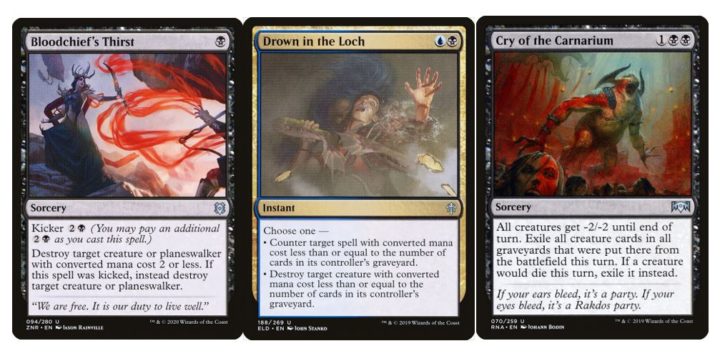
For board wipes, I chose Cry of the Carnarium, Languish, and Yahenni’s Expertise. I was mainly concerned about hyper-aggressive strategies, so I prioritized low mana value board wipes over less restrictive ones. Extinction Event and Shadows’ Verdict are both great options, especially against decks with bigger creatures or tribal synergies like Angels, Elves, or Goblins, but these decks aren’t as popular as they’ve been in the past. I’ve chosen to keep one copy each of these board wipes in my sideboard and would only bring them in for those match-ups.
Hand Hate & Counterspells
After aggressive creature decks, you have to be prepared for control decks. Historic players love to think, so decks like Azorius, Dimir, or Jeskai Control are often popular. I’ll get more into this in the gameplay section, but in general, your best cards here will be hand hate and your own counterspells. As far as hand hate goes, I opted for all the most powerful spells: Thoughtseize, Thought Erasure, Inquisition of Kozilek, and Agonizing Remorse. Duress is another good hand hate spell, but it doesn’t have many uses against non-control decks.
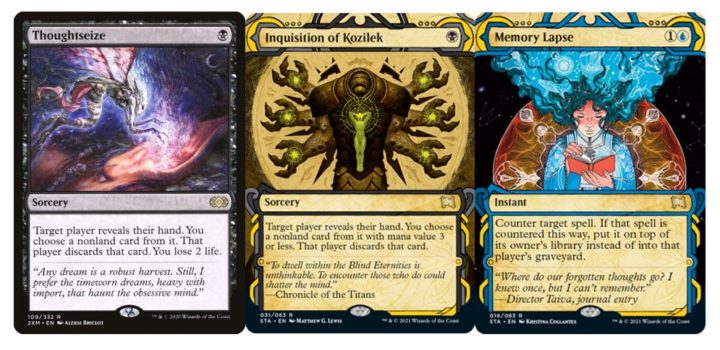
There are many more potential options for counterspells in this deck. Name every counterspell you can think of in the format — Disallow, Saw it Coming, Pact of Negation, Spell Pierce, Miscast, Swan Song, Disdainful Stroke, Censor, Essence Scatter, Negate… The point is, there are a lot, and there simply isn’t enough room for all of them in a Tainted Pact list. Ideally, you’ll want the counterspells that are easiest to cast and the least conditional. Cards like Memory Lapse can counter basically any spell your opponent can throw at you for only two mana. After that, Drown in the Loch also can counter most spells, but that depends on the size of your opponent’s graveyard. You’ll also want to prioritize cheap counterspells so you can cast your combo while holding up countermagic to counter your opponent’s counterspell. More niche counterspells are ready to go in the sideboard for blue match-ups (Mystical Dispute) or match-ups with important instants or sorceries (Test of Talents).
Tutors
Almost every other card in your deck is there to help you dig toward your combo or tutor for a combo piece.
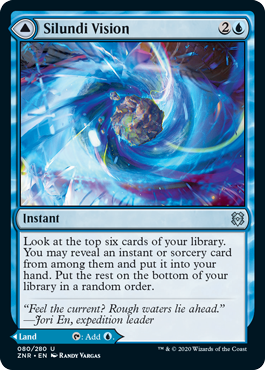
The first card I want to highlight is Silundi Vision. This card sometimes functions as a Supreme Will because it can dig for combo cards or something else you might need. While both are multifunctional and have many benefits, I prefer Silundi Vision, since you can play it as a land when necessary. This deck only plays 23 lands, where other versions are playing 25 lands, so I value modal double-faced cards (MDFC’s) more than an additional counterspell.
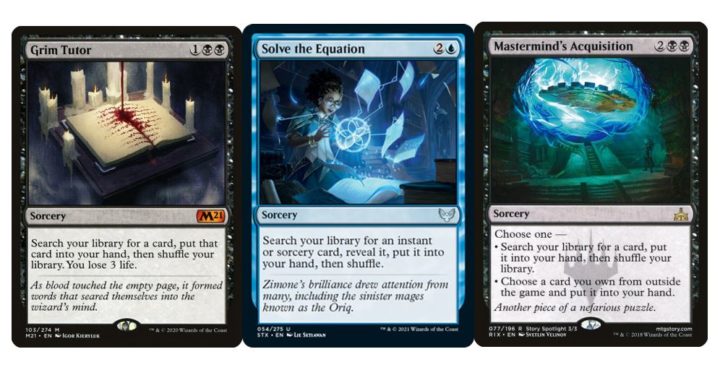
There aren’t many efficient tutor spells in Historic, but Grim Tutor and Solve the Equation both help you get to the combo. Mastermind’s Acquisition is an important tutor because you can search your deck or your sideboard/exile zone, which becomes important in numerous situations. For example, you can grab a combo piece if it gets exiled, or you can get the extra copy of Tainted Pact from your sideboard. It’s sometimes important to leave a spell you want in your sideboard for Mastermind’s Acquisition or the Granted half of Fae of Wishes; however, I typically default to sideboarding in the cards I want in a match-up because there will always be another card I can grab with Granted.
Gameplay
The thing I love most about this deck is that it plays a lot like Splinter Twin back in the best era of Modern. The deck is simply a control deck that can actually win the game in one turn — as early as turn three, as a matter of fact! In a handful of uninteractive match-ups, you can go straight for the combo kill: cast Thassa’s Oracle and respond to the ETB trigger with Tainted Pact to deck yourself. However, it’s not always as simple as having both of these cards in your opening hand. Sometimes, you need to interact with your opponent, either by dealing with their threats or by trying to get your combo to resolve.
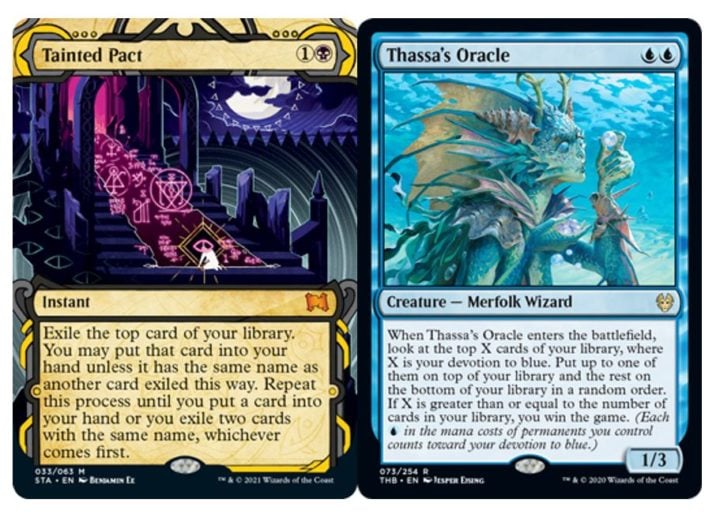
Let’s look at how an aggressive match-up might play out with this deck. Gruul Aggro, for example, is an aggro deck that doesn’t necessarily care about what you’re doing. This makes it very easy for you to combo kill without worrying about interaction from your opponent, but you will need some amount of interaction to stay alive until that point. Ideally, you’ll want a few pieces of spot removal, a board wipe, and maybe a counterspell or two as you work on setting up your combo. If you’re in danger, you can always cast Tainted Pact for a board wipe instead of your combo and play from there. The extra copies of Tainted Pact and Thassa’s Oracle in the deck allow you to play these cards when you need them instead of being forced to hold onto them until you can win the game.
If you’re wondering what a more interactive might look like, let’s look at Jeskai Control. This deck has plenty of ways to disrupt your combo, including Dovin’s Veto, Saw it Coming, and even Memory Lapse. Your hand hate and counterspells are extremely important in the turns you want to win the game or the turns leading up to it. I typically like to build up my card advantage with tutors and card draw until I think I have an opening to win the game. The match-up gets easier post-sideboarding, where you have access to even more hand hate and countermagic.
Of course, there are some other decks that don’t fall into either of these categories, and you’ll want to be prepared for them. Jund Sacrifice isn’t necessarily a bad match-up, but given how popular the archetype is, it’s beneficial to have a couple hate cards for it. Soul-Guide Lantern and Cling to Dust are my go-tos; the latter also hedges against Dimir Rogues as a way to get rid of your graveyard and turn off some of their effects. Lurrus can also enable some nice synergies here, allowing you to play Soul-Guide Lantern or Aether Spellbomb over and over again.
***
One of the coolest things about this deck is how customizable it is, and that’s great news for Tainted Pact players as the metagame continues to grow and develop. We’ve been seeing an increase of control decks in the metagame, so adding more countermagic in place of some spot removal might be beneficial moving forward. Of course, the opposite becomes true if Gruul Aggro rises to the top of the meta, but my point stands: Tainted Pact decks are highly adaptable and can be tooled to beat any deck you want. You can’t say the same about most combo decks in Historic — let alone ANY deck in Historic!
Check out my Twitch channel for some Tainted Pact gameplay!

Ally Warfield is a member of the Rivals League, a full-time streamer, and a Splinter Twin apologist. Her focus is in Historic and Standard, but she also loves to dabble in Vintage and Limited formats as well.

